Thursday, October 10th, 2019
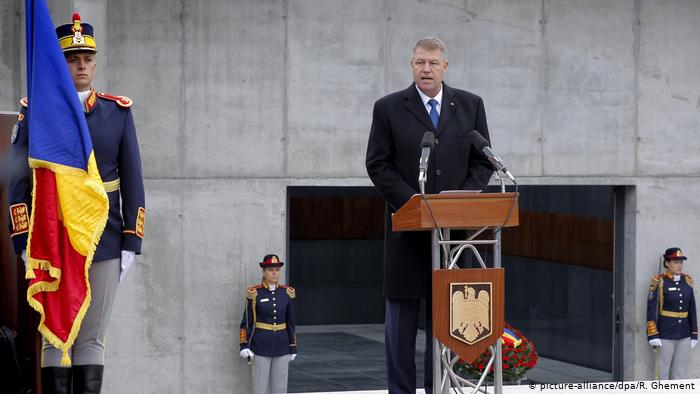
Romanian President Klaus Iohannis announced on Tuesday in Bucharest his approval for the creation of an official Romanian Holocaust Center under the auspices of the Elie Wiesel Institute for Study of the Holocaust.
By Carolyn Yeager
President Klaus Iohannis announced on Tuesday (Oct. 8) his official approval for the creation of the country’s first Holocaust museum in Bucharest, Romania’s capital. He said in a ceremony attended by ‘holocaust survivors’:
“The history of Jewish Romanians, their contribution to the country’s development and the tragedy experienced during the war… represent a legacy which was hidden from us for decades.”
He added: “This museum will not so much bring answers as raise more questions.” He said the goal was to recover the memory of the Holocaust [or maybe to invent it where necessary?]; strengthen the education about the Holocaust, and combat anti-Semitism [oh yes, that too – the actual main goal]. The museum will take up space in a WWII era eight-story building in central Bucharest.
Elie Wiesel behind the museum plan
The new museum will be coordinated by the Elie Wiesel Institute for the Study of the Holocaust in Romania, a “think tank” created by Wiesel and his handlers in 2005. Wiesel claims to have been born in Sighet, Hungary in 1928, which is now part of Romania. In 2004 an international panel led by Elie Wiesel estimated that between 280,000 and 380,000 Romanian and Ukrainian Jews perished from territories under Romanian administration from a total of 750,000. It also found 11,000 Roma were killed. For reliability of Elie Wiesel Institute facts and figures, see “Elie Wiesel Institute Wrong on Romanian Grave Claims.” Also, previous story here.
Elie Wiesel died in 2016.
Only 3,200 (admitted) Jews still live in Romania, according to the last census in 2011; other sources say 8,000 to 10,000. [Jews moved to New York where the living is better. Thousands of others changed their identity to Christian and remain in Romania officially undetected.]
Romania switched sides in the world war in 1944. The government was originally strongly allied with the victorious Germany, but when the tide turned, the Romanian army deserted and opportunistically, with all their German weapons and gear, went over to the Allies. Romania was therefore under Soviet communist control for the next 45 years, remaining a backward, dreary and corrupt country. That was in large part what drove so many Jews to leave. They want communism for Gentiles, but not for themselves.
Sunday, December 23rd, 2012
By Carolyn Yeager
copyright 2012 carolyn yeager
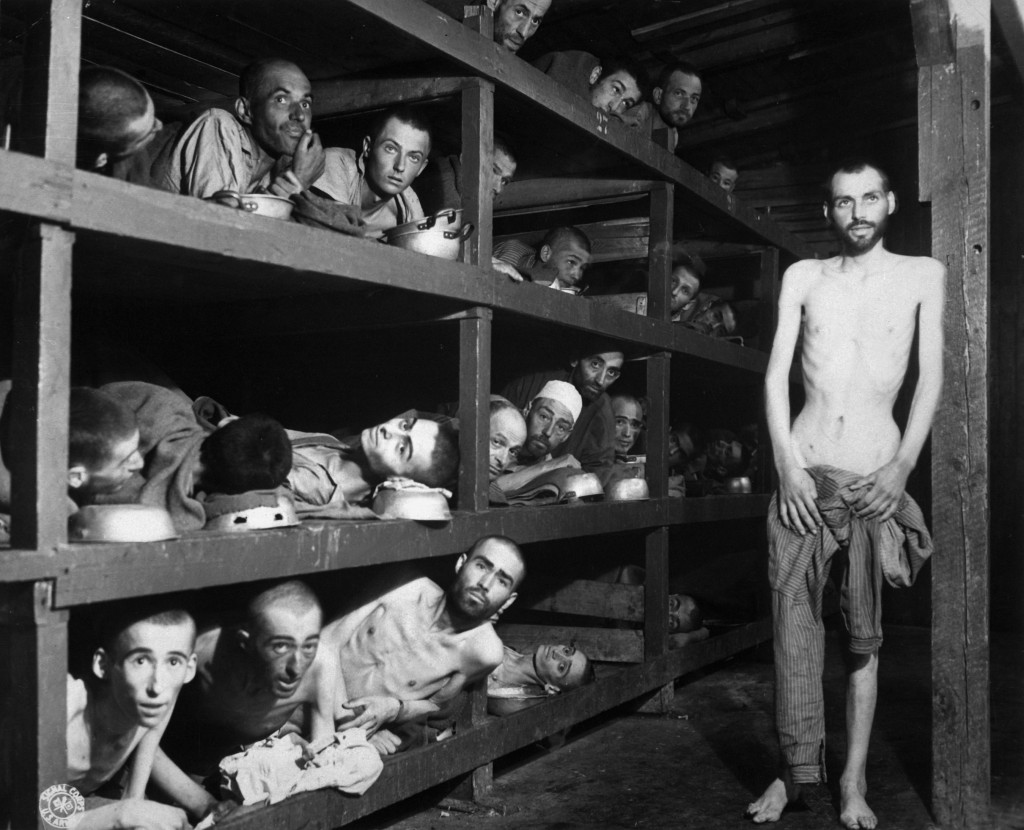
Do you remember the nursery rhyme that goes:
Sugar and Spice and all things nice, that’s what little girls are made of.
How about this one:
Magic and Trickery and all things fakery, that’s what “the holocaust” is made of.
This very famous image associated with the so-called “Holocaust” that was discussed in the previous post has turned out to be fraught with fakery. A sharp-eyed reader, Paul Borresen, noticed something that, once seen, makes one wonder how it was not seen before!
What he noticed is that, in addition to the forged standing man exposed in my previous post, one of the men in the bunks appears twice in this Famous Buchenwald Lie-beration Photo, and the similarity is unmistakeable.
Viewing the photo above, enlarged as much as it can be … find the young man lying on his back with head turned toward the photographer, in the 2nd row up from the bottom, 3rd from the left. His head is resting on his food bowl. (close-up on left, below, designated ‘Original’)
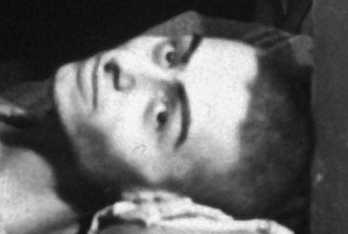
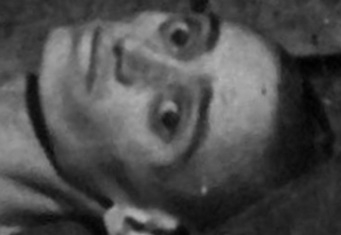
Now look at the young man in the same position in the bottom row, 4th from the left. He is the same man! (close-up on right, above, designated ‘Copy’) The food bowl has been removed from underneath his head, leaving it to a military intelligence photo-retoucher to redo his throat and neck, but in a very un-anatomical manner. Have you ever seen a neck that looked like that? I have not. In an attempt to retain a lesser portion of the ‘gown’ he was wearing so that it would not look the same as the ‘original,’ more bare skin is left showing, but without any anatomical correctness whatsoever.
The retoucher was not a trained artist and was in over his/her head with this assignment. For example, look at the ear. It consists of a few strokes of light-colored paint in an attempt to make something resembling an ear, but failing. Ears are one of the most difficult parts of the body to draw or paint in a convincing manner, but it was necessary to add an ear to this ‘copy’ because the ear is not showing on the original man in the bunk above; it is buried against the upside-down food bowl and some material that’s covering it. The botched ear of the ‘copy’ is one of the biggest giveaways of fakery in this photo, but not the only one.
What’s with all these thick, black eyebrows?
Let’s look at the eyes and eyebrows next. The man whom we are calling “the original,” has very dark, thick eyebrows but otherwise looks normal. The shadow under his chin is probably what was actually there – bringing attention to the fact that a very bright light source in a dark room was shining on the men, and hitting the lower two rows of bunks more than the upper two rows. His “copy” also has very dark, flat eyebrows but they have been redrawn to begin higher up from the bridge of the nose and extend down to the outside corner of the eye, giving him a wild look. Adding to this wild-eyed look is the delineation of more distinct eyelids, rounding the eyes and enlarging the irises, all of which create the zombie look which the ‘original’ doesn’t have.
A couple more things were done in a futile effort to camouflage this ‘copy’: the rounding of the forehead, head, and hairline, and the squaring of the chin and lower jaw. A crude line of black paint, applied all the way up to the big, white ‘cauliflower’ ear, was evidently thought to suffice for a shadow under chin and jaw. Look closely especially where it meets the ear and you can recognize it is paint.
Yet, the nose, mouth, upper jaw and facial shadows remain exactly the same in both figures. The result is a grotesque second person that I suppose has been eliciting sympathy from clueless viewers all these years.
This grotesque, over-worked ‘copy’ is also smaller than it should be for the bunk it occupies – actually being the same size as the man peering out from the next bunk further down. Maybe the forgers thought this would make him look like a young boy. If so, they failed to realize that boys don’t have tiny heads! Now, this peering man has clearly had his eyebrows and eyes emphasized with black paint or pencil. Or he may be totally fake. Others whose eyebrows were treated similarly are: The “elie wiesel” face has heavily emphasized eyebrows; also the second and third man in the third row, and all the men in the top row. I believe the best explanation for this phenomenon is this: the poorly painted eyebrows of the ‘copy’ would stand out too much from the natural-looking eyebrows of all the rest, so it was decided to give a swipe of black paint to many other eyebrows also, including our ‘original.’
As a practicing artist most of my life, from childhood on, who has drawn and painted hundreds of faces and done many portraits, I know quite well how to touch up faces and how tiny adjustments can make a big difference in attaining a likeness. The assignment here was to do the opposite of attaining a likeness; it was to take a photographic carbon copy and make it look unlike the original. If I had done the work on this photograph it would be far superior to the image we have, which is a really sloppy job by people who are not artists and therefore don’t have “an eye” for how things actually look and/or don’t know how to make it look that way. Which is a good thing for us!
NEW ENLARGED IMAGES! In these close-ups showing more of the neck and the space around the faces. we can see more clearly how the head of the “copy” in the lower bunk is angled back, just slightly, since he is lying with his head directly on the floor of the bunk, not propped up as is the “original.” I think it’s likely that after altering the face and hair, and adding an “ear,” the forgers severed the face/head at the jawline and proceeded to paint a brand new neck that would fit the newly angled face with the slightly raised chin. This is why everything below the chin is so horribly wrong. We can see a collar bone and shoulder in the ‘original,’ but there is no bone structure at all in the ‘copy.’ The crude black line representing a shadow under the chin serves to “attach” the two parts together.
The ‘copy’ also has far less contrast, is overall grayish, which would happen from all the retouching, or also that this copy was set for low contrast. We can see that the shadows on the side of the face follow the same pattern even though they’ve been interrupted here and there. We can also see clearly how the upper line of the face was indented right below the cheekbone, and was added to along the mouth area. The line of the mouth between the upper and lower lips goes all the way to the edge of the face, but on the ‘copy’ it stops short of the edge. You can see the gray paint added at that upper corner of the mouth.
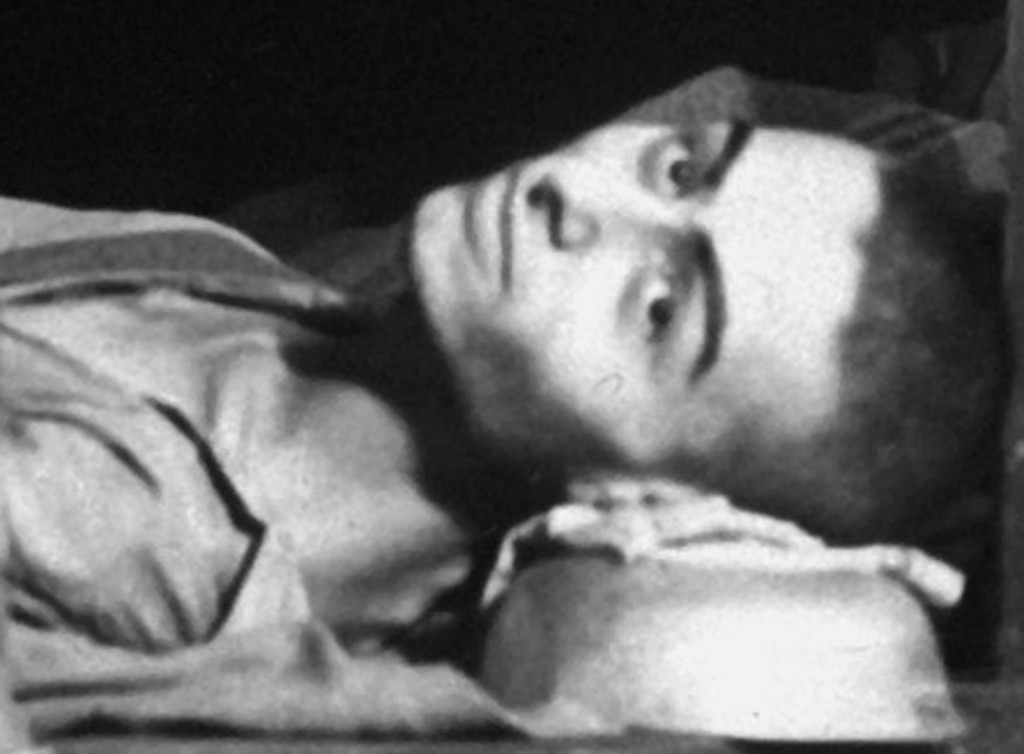
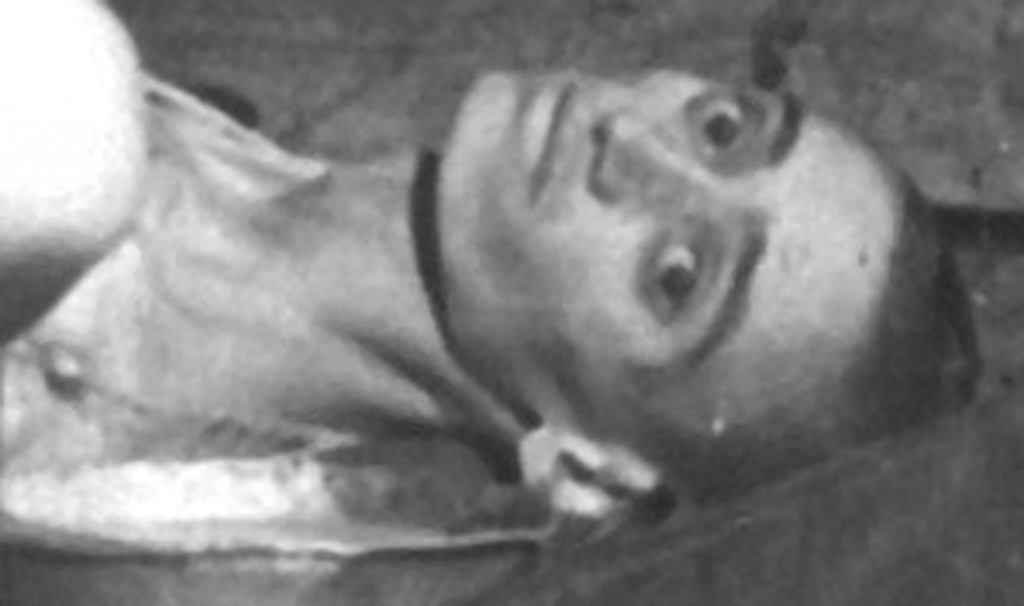
Hundreds of forged and mislabeled photographs make up the “Holocaust”
This is one photograph out of many that were also forged. I believe it is one of the most important because it has been given such a prominent place among the documents “proving” the “Holocaust.” Elie Wiesel, or his handlers, no doubt selected this photo – from many possible others wherein he could be falsely identified as one of the crowd – because it was already so well-known and was in many books and publications. Therefore, whenever it is published somewhere, it can be said that Nobel Prize winner Elie Wiesel is in the picture. However, they didn’t count on it being exposed as a fraud – they never do. But now it has been, and it’s up to us – all of you reading this – to see that the exposé becomes known everywhere this photograph appears. This is what it will take to break the spell.
What we have to fight against – our own people
A fellow revisionist who helps me with technical issues from time to time for this blog actually wanted me to hold back on this because he could not be sure that the two figures discussed in this article are the same man! What would it take to convince him? A confession from the perpetrators? A corroboration from an authority figure or a Jew? Why the difficulty in contradicting the given narrative?
A poster at Stormfront who boldly calls himself “The Hammer of God” had this to say when confronted with the empty black area in the NYTimes reprint:
Idk, newspapers did have pretty low-quality pictures at that time, so maybe that whole area was just set to black, but it looks bright enough for that person to have shown up. The lighting actually seems a bit brighter on that man, which makes it even stranger why that section would appear black. So, perhaps it is a forgery, but I can’t say for certain.
People like ‘The Hammer” should spend more time studying how the magic spell works. It works like this: Evidence doesn’t count; don’t trust it; don’t trust your own brain; trust the consensus. Far too many of us cannot break out of the consensus about the “Holocaust” and the ” evil Nazis.” For this reason, we need to clearly understand what is being done, and how it’s being done. The “how” is very important. It’s a kind of sleight of hand, a magic act, and we are the ones being both entertained and kept in servitude by it. Understanding this is how we will break the spell.
7 Comments
Category Featured | Tags: Tags: Elie Wiesel, fakery, famous Buchenwald photo, Holocaust, magic, photo retouching, trickery,
Social Networks: Facebook, Twitter, Google Bookmarks, del.icio.us, StumbleUpon, Digg, Reddit, Posterous.
Wednesday, September 28th, 2011
With Commentary by Carolyn Yeager
This Q & A was presented in the Post and Courier newspaper on September 18 as a question & answer session in connection with Elie Wiesel’s speech at the College of Charleston (South Carolina) on Sunday, Sept. 25.
I have added some comments and questions that I would have liked to ask Mr. Wiesel had I been allowed to be present. Of course, this was a very controlled event, if it were not, in fact, private, one week before the speech. The main interest here is how Wiesel skirts around all questions and gives the same pat answers that he has been giving for years. He has rehearsed what he will say and does not go beyond his rehearsed answers; thus his answers never change and often strike an aberrant note, as if not directly relating to the question. ~cy
The first picture accompanying this news story is the famous one that is permanently associated with Wiesel wherever he goes.
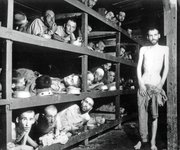
The caption tells us that Wiesel is in the picture, but we, the followers of this blog, know that he is not and that a Gigantic Fraud has been carried out concerning this picture, by powerful forces such as the New York Times, and by Wiesel himself.
Q: In your book “Night,” you describe the ardent faith you practiced as a child and address the dilemma of a compassionate God, making it clear that because of the Holocaust and what you witnessed during your ordeal, you became a skeptic. Are you still asking questions? What is the nature of your faith or nonfaith today?
A: First question, yes, I continue asking questions. I belong to the Talmud tradition. The Talmudic tradition actually emphasizes the question, much more than the answer. Answers come and go, the questions are eternal. When it comes to the question of faith, of course, … profound or painful. So what I say to myself is, “Of course I believe in God.” I believe in God because my father and my grandfather and his and so forth, they all believed, and (down) the line — I hope I’m not the last. … But my faith is a wounded faith.
Comment: Wiesel is proud to be Talmudic. In his tradition, answers are not expected. Perhaps answers are not even missed, for Talmudic Jews take pride and pleasure in endlessly discussing what is God among themselves. They determine God; it is not God who informs them. Wiesel says he continues to profess belief in God because he wants to honor his ancestors. It is a Jewish tradition.
Q: And what about the concept of justice? Is it possible to reconcile it with the abomination that was the Holocaust?
A: To me, this is the question of all questions. On many levels, I don’t understand God, which I cannot. We have a very, very great sage called Rabbi Eliezer HaKalir. He was a great, great thinker and a poet, too. And he said, “If I knew God I would be God.” So nothing concerning, really, the definitive God, the Almighty, Just, the King of the Universe is a question. I don’t know how it’s possible He knew and yet he is silent. So the silence of God troubles me. But it doesn’t stop there. The silence of the world’s leaders also troubles me.
Comment: The King of the Universe, says Wiesel, is silent about the Holocaust. Could it be because it is untrue and their God doesn’t or can’t acknowledge what is false and has no reality? In any case, Wiesel would rather focus on the world and its leadership.
Q: There’s sacred justice, but there’s also human justice.
A: Yes. Human justice. Exactly.
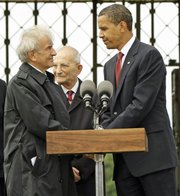
The next picture shows President Barack Obama shaking hands with Elie Wiesel, who specifically invited the U.S. president to visit the former Buchenwald camp during his trip to Germany in June 2009. Wiesel has great influence as the most famous survior of Buchenwald … but wait! He wasn’t at Buchenwald. There are no records of his being there and he is not in the famous photograph above. What kind of trick is being played on the unsuspecting President Obama?
Q. And what about that? Humans are so fallible, as we know, and their justice is imperfect. Do you still think that (human) justice could ever match the depth of the injustice of the Holocaust itself?
A: It comes to define justice. Justice with a capital J — absolute justice — is one question. But the justice which has, — how to say? — betrayed, perverted human beings, that’s another question.
Comment: This answer doesn’t answer anything. Instead, it repeats the question–a typical Wieselian response.
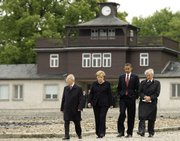
Another iconic photo chosen for this story is this one also taken at Buchenwald in 2009. It shows Obama and German Chancellor Angela Merkel walking with Wiesel (on the right), who is “showing them around.” I believe this is his very first visit there. But then, that’s no doubt true for all of them.
Q: Has life for you continued to be a long “night”? If so, what has kept you going? What, if anything, gives you joy?
A: Joy. … I see children, I have joy. I have my grandchildren, I have joy. On the other hand, I remember that we lost almost 2 million children. So the joy is not a perfect joy anymore.
Comment: Apart from the fact that 2 million children were not lost, Wiesel is a millionaire, lives in one of the highest priced locations in the world, is listened to by rulers, presidents and celebrities; has hundreds of people to do his bidding. The public treats him with reverence. His beloved State of Israel has become a great power. But I guess we’re to believe he is really suffering.
Q: Has there been any change, any little glimmer of light that managed to penetrate the “night”?
A: The answer is yes, it must be. It must. I think it was (Albert) Camus who said when there is no happiness, you must create happiness. That goes for joy, that goes for peace, that goes for all the good things in life. To say that night has vanished, no, it’s not, it’s still there. But paradoxically, other things came afterwards, and they, too, are as real. In other words, I would still say night is long and infinite, but I’m not alone in this world.
Comment: Time for the violins to start playing in the background.
Q: And in a way, perhaps, your writing itself, all the books, has helped to create some semblance of happiness for you?
A: Only if other people are happy and feel victorious over sadness. My happiness must be a result of theirs.
Comment:The violins are still playing.
Q: The Holocaust surely was an aberration, an example of Fascism run amok. But Fascism has a tendency to run amok, as you repeatedly have pointed out. You have condemned genocides and reminded the world that it must remain vigilant. How do you categorize the Holocaust? Was it unique in its nature, or only its scale?
A: No, I think it was unique; therefore, it must remain unique in memory. Once you say that it’s not, it opens history again to other mass murder. History has proven that it can and, therefore, it may continue.
Comment: Take notice! Wiesel is making it clear: the Jewish Holocaust was unique! His reasoning (?) is that if it were not, new genocides can happen. The Holocaust, by being unique, closes history to more mass murder. (This is perilously close to saying the Jews died so that others would not — an aspect of their hidden agenda to replace Christ with The Jew.) But he follows by saying it can, and may, continue. As he said at the beginning, there are no answers … not from God and not from him.
Q: You have long been a supporter of Israel, and were once invited to consider public office there.
A: (Laughing) I was offered to be a president. I was under pressure in the first few weeks, and, you know how it is, the more I said no, the harsher the pressure grew.
Comment: He has a close relationship to all top Israeli politicians, from at least 1950 on.
Q: So what made you decide to stay in the United States?
A: I came here in 1956. I came as a stateless person. Can you imagine? You cannot, because you were born here probably. … And here I came, I was accepted by the United States as an American citizen. And I had my passport all the time with me because I never had another passport in my life. So I owe this country quite a lot. I love this country.
Comment: This is an insincere answer. He could have become a citizen in any state, certainly in France even when he was underage. He didn’t want to. He wanted to be in the most powerful country, the one the Jews of Israel planned to control. This is why he came to the U.S. and devoted himself to projects like bringing into existence the United States Holocaust Memorial Museum, a huge victory for Jews.
Q: Do you ever worry about the ways in which the Holocaust has defined Jewish identity since the war?
A: Well, I know I read about it. Some people believe this is exaggerated — we shouldn’t do that. I don’t like to turn it into an object for discussion. … What every person does or thinks with regards to (an event), I don’t want to put myself in their soul-searching. I think memory is what defines a human being and society. If you betray memory, you betray yourself and all those who believe in it.
Comment: He doesn’t answer the question. In truth, the ‘Holocaust’ has defined not just Jewish, but Anglo-American and European identity in ever-increasing strength since 1945. It is non-Jews who should be very worried about how the Big H has defined our identity, which is why Wiesel avoids the subject.
Q: When it comes to Jewish identity, how important is Israel? And what do you think should be done to resolve the conflict there?
A: I’m optimistic. … My foundation has created many things. My foundation is the one that brought together the prime minister of Israel (Ehud Olmert) and (Palestinian Authority) President (Mahmoud) Abbas. (Note: The historic first meeting of Olmert and Abbas took place at the Elie Wiesel Foundation’s second annual Conference of Nobel Laureates in Petra, Jordan, on June 22, 2006.) For the first time, they met under our auspices, and they met, they fell into each other’s arms with tears in their eyes. I turned to my wife, I said, “Look.” This is the best event that I witnessed in many, many years. Which means it can be done, therefore, it will be done, my feeling is within a year or two.
Comment: How evasive is that? He brings up something that occurred in 2006 – 5 years ago! This is more avoidance of facing the real crisis that Jewish Israel has brought about by its constant theft in the name of establishing an ‘identity’ for itself.
25 Comments
Category Featured | Tags: Tags: Angela Merkel, Barack Obama, College of Charleston, Elie Wiesel, Holocaust, Jewish identity, Post and Courier, Talmud,
Social Networks: Facebook, Twitter, Google Bookmarks, del.icio.us, StumbleUpon, Digg, Reddit, Posterous.










